3dsmax 9 - SPECapc 3dsmax CPU Rendering Test
Today's desktop processors are more than fast enough to do professional level 3D rendering at home. To look at performance under 3dsmax we ran the SPECapc 3dsmax 8 benchmark (only the CPU rendering tests) under 3dsmax 9 SP1. The results reported are the rendering composite scores:
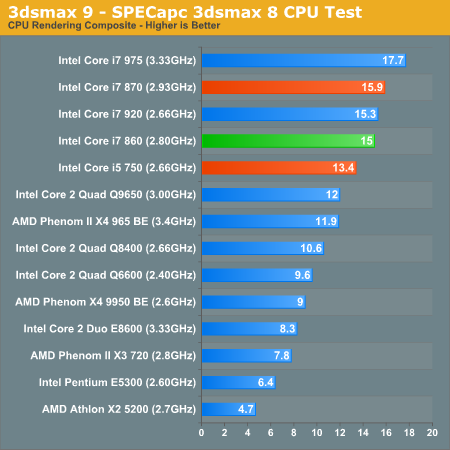
There are definitely cases where Bloomfield's memory controller is a boon, the Core i7 860 is able to approach but not outperform the i7 920.
Cinebench R10
Created by the Cinema 4D folks we have Cinebench, a popular 3D rendering benchmark that gives us both single and multi-threaded 3D rendering results.
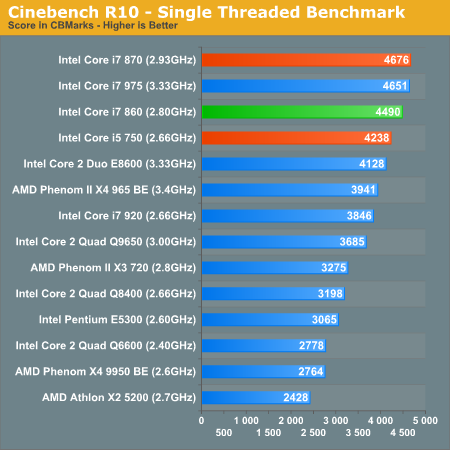
Since threaded performance is excellent on the 860, after all it's running at 3.46GHz in this situation. The 920 doesn't stand a chance.
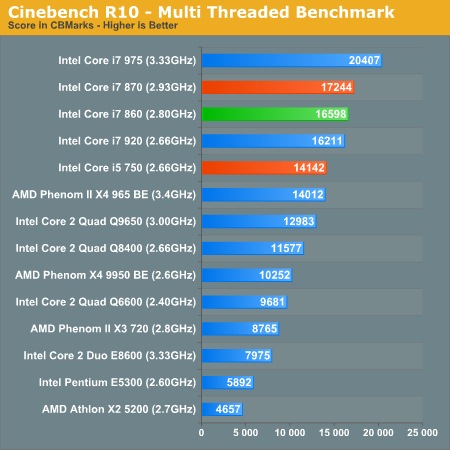
Up the thread count and we see the Core i7 860 slightly ahead of the 920.
Blender 2.48a
Blender is an open source 3D modeling application. Our benchmark here simply times how long it takes to render a character that comes with the application.
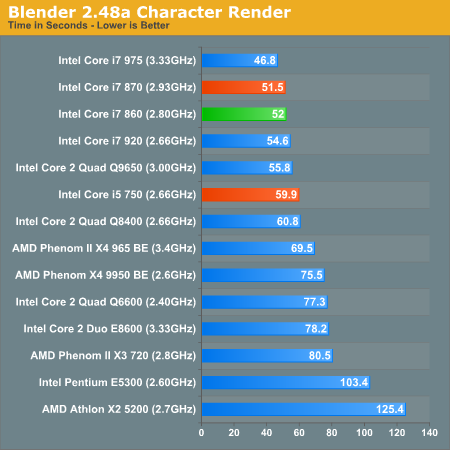
Blender performance is again faster than a 920 and nearly on par with the Core i7 870.
POV-Ray 3.73 beta 23 Ray Tracing Performance
POV-Ray is a popular, open-source raytracing application that also doubles as a great tool to measure CPU floating point performance.
I ran the SMP benchmark in beta 23 of POV-Ray 3.73. The numbers reported are the final score in pixels per second.
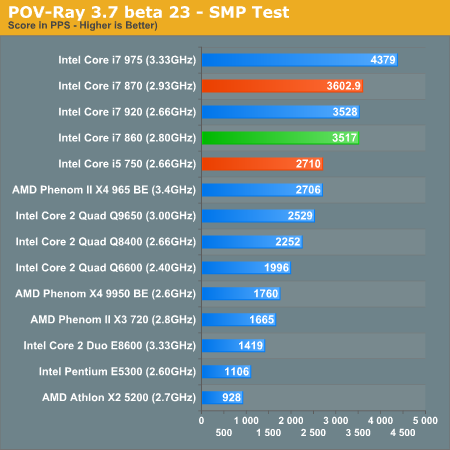
POV-Ray performance is nearly on par with the Core i7 870 and equal to that of the i7 920.










121 Comments
View All Comments
Griswold - Saturday, September 19, 2009 - link
Well, you didnt go away either...coolkev99 - Monday, September 21, 2009 - link
In the zorro's world, processors can only be a fixed speed. Since Intel's newest dynamically changes he thinks it's somehow cheating.I wonder if the zorro thinks mobile CPU power saving features are cheating when they throttle down to save energy?
Just because a CPU can now change thier speed based on needs does not mean it's cheating. Better get used to it as this is the future of multicore CPUs.
vol7ron - Saturday, September 19, 2009 - link
You already made a similar comment in the other article. It's not overclocked, you're a moron. It's the same as saying that it underclocks as it uses more cores. That's the stock speed, which varies. Overclocking occurs when users modify the speeds beyond the specifications.Get over yourself AMD fanboi.
Nich0 - Saturday, September 19, 2009 - link
I don't be too much of a PITA, but surely the 'real' overclocking frequencies for the 860 should be of the 21*BCLK variety, no? Because it's stock rated speed is 21*133, its overclocked-at-stock-voltage-with-turbo speed should be 21*150 instead of 22*150. Looks to me as there's some kind of turbo going on on the CPUZ screenshots. Or am I missing something?iwodo - Saturday, September 19, 2009 - link
It is hardly surprising they are not selling well.Because, Nehalem didn't make as Big Jump as C2D in performance.
It is expensive, not only the chip itself. But the platform. Pentium 4 to C2D doesn't require new memory. And in some cases doesn't require new Motherboard as well.
Athlon Quad Core is Cheap. Consumers cares about Cores, not threads.
Economy doesn't allow to spend money upgrading on what is already working perfectly.
SSD offer much better value for money in terms of upgrade and investment.
No Integrated Graphics for Nehalem yet. ( Money need to spend on Graphics. )
Personally i am waiting for Sandy Bridge ( or even Ivy Bridge for FMA )
zero2dash - Tuesday, September 22, 2009 - link
It doesn't?My socket 478 P4 3.0C would like to disagree with you, considering that it used DDR ram. Practically all of the later P4's were s775, using DDR2 boards.
I wanted to upgrade - I bought a new board and new ram to go along with it.
zero2dash - Tuesday, September 22, 2009 - link
Ack, frickin' quote didn't work.[quote]Pentium 4 to C2D doesn't require new memory.[/quote]
afkrotch - Tuesday, September 22, 2009 - link
The move from P4 to C2D can be huge or small.1. new proc
2. new mobo
3. new memory
4. new gpu
5. new psu
You were required to pick up 1-5 new parts. When I upgraded, I needed all 5.
Stating about saving money, then saying an SSD offers much better value for money in terms of upgrade and investment. WTF. As of right now, it's probably the worst choice, unless you already have the best parts available.
Dobs - Sunday, September 20, 2009 - link
I think P55 may be the problem - without USB 3.0, PCIe 3.0 SATA 6gbsIf all were included it would be a must have - even 1 of the 3 would make it very tempting.
Perhaps they could release them like "Draft n"... That may get sales moving.
Griswold - Saturday, September 19, 2009 - link
I'm not so sure this is fact. Other rumors say, Intel aims for 1 million shipped chips by the end of 2009. Thats not exactly shabby, bad or "not so good". Intel, historically, has a pretty good grasp of what is possible due to their very close ties with their partners.http://www.digitimes.com/news/a20090916PD219.html">http://www.digitimes.com/news/a20090916PD219.html
Then again, this could also be just a rumor without much truth to it. We'll have to see whos right.
But I already know that you're right with some of what you said. I was not impressed with i7 (LGA1366). I was waiting for i5/i7 (LGA1156). And while I think it can be a good product for a relatively fair price (depending on which model you take), I cant justify ditching my Q6600 for it just yet. The best reason would be power consumption and turbo.
Instead, I went with a SSD and got more improvement out of that than any other upgrade could possibly deliver.
The 32nm parts may be interesting again. If not, I'll just wait for sandy bridge. Or maybe even AMDs bulldozer. My current system will take me there easily...